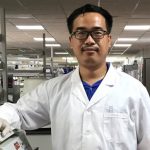Plant Science Research Weekly: August 14, 2020
Multi-omics reveals mechanisms of total resistance to extreme illumination of a desert alga
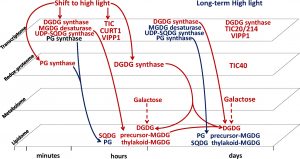 The green alga Chlorella ohadii was recently isolated from the harsh environment of desert biological sand crusts, where it is able to grow and thrive in extreme conditions. Previously, studies showed that it is unusually resistant to photodamage, even at twice the irradiance of maximal sunlight thanks to mechanisms that maintain high rates of photosynthesis and growth under extreme irradiances that usually damage the photosystem II (PSII) and saturate photosynthesis. To further explore its resistance to photodamage, Treves et al. grew C. ohadii cells in photobioreactors under three irradiance regimes: 100 μmol photons m−2 s−1 (LL), 3,000 μmol photons m−2 s−1 (continuous extreme irradiance level – EIL) and 18.5 h LL followed by a shift to EIL (LL→EIL), and generated multi-omics analysis at different times after exposure to EIL. After 3 min under EIL, C. ohadii cells showed a rapid post-translational redox response, which promoted NADPH shuttling, NADPH consumption, heat shock responses, and lipid biosynthesis. The transfer to EIL induced the CO2-concentrating mechanism (CCM), which facilitated a lower rate of photorespiration, verified by a fall in glycolate levels and looseness of photorespiration gene expression. The unusual C. ohadii response of thylakoid stacking under EIL conditions was explained by the increase in digalactosyldiacylglycerol content, which promotes stacking. The authors suggest that highly efficient reductant utilization preceded the evolution of a stable PSII, but further studies are needed. (Summary by Elisandra Pradella @Elisandra_MP) Nature Plants 10.1038/s41477-020-0729-9
The green alga Chlorella ohadii was recently isolated from the harsh environment of desert biological sand crusts, where it is able to grow and thrive in extreme conditions. Previously, studies showed that it is unusually resistant to photodamage, even at twice the irradiance of maximal sunlight thanks to mechanisms that maintain high rates of photosynthesis and growth under extreme irradiances that usually damage the photosystem II (PSII) and saturate photosynthesis. To further explore its resistance to photodamage, Treves et al. grew C. ohadii cells in photobioreactors under three irradiance regimes: 100 μmol photons m−2 s−1 (LL), 3,000 μmol photons m−2 s−1 (continuous extreme irradiance level – EIL) and 18.5 h LL followed by a shift to EIL (LL→EIL), and generated multi-omics analysis at different times after exposure to EIL. After 3 min under EIL, C. ohadii cells showed a rapid post-translational redox response, which promoted NADPH shuttling, NADPH consumption, heat shock responses, and lipid biosynthesis. The transfer to EIL induced the CO2-concentrating mechanism (CCM), which facilitated a lower rate of photorespiration, verified by a fall in glycolate levels and looseness of photorespiration gene expression. The unusual C. ohadii response of thylakoid stacking under EIL conditions was explained by the increase in digalactosyldiacylglycerol content, which promotes stacking. The authors suggest that highly efficient reductant utilization preceded the evolution of a stable PSII, but further studies are needed. (Summary by Elisandra Pradella @Elisandra_MP) Nature Plants 10.1038/s41477-020-0729-9
Calcium binding by arabinogalactan polysaccharides is important for normal plant development
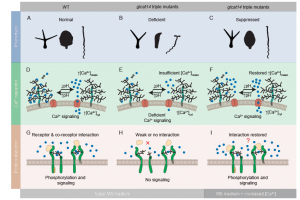 Arabinogalactan proteins (AGPs) are a class of apoplastic carbohydrate-binding proteins with a carbohydrate portion that can also bind to calcium (Ca2+) ions in a pH-dependent manner. Here, Lopez-Hernandez and colleagues have probed the role of AGPs and the functional significance of their Ca2+-binding using mutants deficient in enzymes required for the assembly of carbohydrate moieties. Analysis of the mutants revealed a compromise in the composition of carbohydrates bound to AGPs, a reduction in Ca2+ binding, and severe growth defects in higher-order mutants. Interestingly, the growth defects, including trichome branching and de-etiolation, seemed to be dependent on external Ca2+ concentration. Further, hydrogen peroxide-induced Ca2+ signals were also attenuated in the mutant plants, which showed altered cell-to-cell movement of the Ca2+ signal. Thus, the ability of AGPs to bind Ca2+ may underlie several development aspects of plants and may also contribute to stress-induced cytosolic Ca2+ signaling. The authors suggest that AGPs act as extracellular reservoirs of Ca2+, which can accumulate Ca2+ and release it into the cytosol in case of stress conditions depending on changes in apoplastic pH. (Summary by Pavithran Narayanan @pavi_narayanan) Plant Cell 10.1105/tpc.20.00027
Arabinogalactan proteins (AGPs) are a class of apoplastic carbohydrate-binding proteins with a carbohydrate portion that can also bind to calcium (Ca2+) ions in a pH-dependent manner. Here, Lopez-Hernandez and colleagues have probed the role of AGPs and the functional significance of their Ca2+-binding using mutants deficient in enzymes required for the assembly of carbohydrate moieties. Analysis of the mutants revealed a compromise in the composition of carbohydrates bound to AGPs, a reduction in Ca2+ binding, and severe growth defects in higher-order mutants. Interestingly, the growth defects, including trichome branching and de-etiolation, seemed to be dependent on external Ca2+ concentration. Further, hydrogen peroxide-induced Ca2+ signals were also attenuated in the mutant plants, which showed altered cell-to-cell movement of the Ca2+ signal. Thus, the ability of AGPs to bind Ca2+ may underlie several development aspects of plants and may also contribute to stress-induced cytosolic Ca2+ signaling. The authors suggest that AGPs act as extracellular reservoirs of Ca2+, which can accumulate Ca2+ and release it into the cytosol in case of stress conditions depending on changes in apoplastic pH. (Summary by Pavithran Narayanan @pavi_narayanan) Plant Cell 10.1105/tpc.20.00027
Fission control in Chlamydomonas
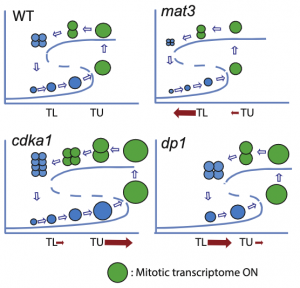 Chlamydomonas, like many green algae, divides by so-called “multiple fission” where the mother cell can grow many-fold in size before undergoing a series of rapid divisions. The dramatic separation of cell growth from cell division makes Chlamydomonas an attractive system to study genetic control of cell size homeostasis. In this paper by Cross, we learn that CDKA1, a conserved cell cycle kinase, sets the critical size required for irreversible commitment to division, probably by activating the large mitotic transcriptional program. Surprisingly though, once the cell is committed, CDKA1 plays almost no part in subsequent progression through the cell cycle and has minimal effect on daughter cell size. In contrast, two other genes, RBR/MAT3 and DP1, are primarily important for size homeostasis by controlling the number of divisions that a cell will perform. These observations are summarized in a compact hysteresis model of the Chlamydomonas cell cycle with two transition thresholds: a CDKA1-dependent threshold for cell cycle entry, followed by MAT3-DP1-regulated maintenance of the mitotic state. (Summary by Frej Tulin @FrejTulin) Curr. Biol. 10.1016/j.cub.2020.03.019
Chlamydomonas, like many green algae, divides by so-called “multiple fission” where the mother cell can grow many-fold in size before undergoing a series of rapid divisions. The dramatic separation of cell growth from cell division makes Chlamydomonas an attractive system to study genetic control of cell size homeostasis. In this paper by Cross, we learn that CDKA1, a conserved cell cycle kinase, sets the critical size required for irreversible commitment to division, probably by activating the large mitotic transcriptional program. Surprisingly though, once the cell is committed, CDKA1 plays almost no part in subsequent progression through the cell cycle and has minimal effect on daughter cell size. In contrast, two other genes, RBR/MAT3 and DP1, are primarily important for size homeostasis by controlling the number of divisions that a cell will perform. These observations are summarized in a compact hysteresis model of the Chlamydomonas cell cycle with two transition thresholds: a CDKA1-dependent threshold for cell cycle entry, followed by MAT3-DP1-regulated maintenance of the mitotic state. (Summary by Frej Tulin @FrejTulin) Curr. Biol. 10.1016/j.cub.2020.03.019
Cleavage-furrow formation without F-actin
 The contractile actomyosin ring (CAR) would be familiar to most students of cell biology. It is often assigned a major role in the formation of the cleavage furrow that bisects the cell during cytokinesis. The contractile force of the ring is generated by type-II myosin motor proteins pulling on actin filaments. However, although division by cleavage furrow formation is widespread among eukaryotes and likely represents the ancestral state, type-II myosins, which are key to the CAR model, are almost exclusive to animals, yeasts and their close relatives. This observation has raised questions about how non-animal/yeast organisms form a furrow, and about the role of actin in myosin-II-less division. Onishi et. al explored these questions in the green alga Chlamydomonas, a representative organism that divides by forming a cleavage furrow but does not encode any type-II myosin. Although filamentous actin was found associated with the cleavage furrow, depletion of actin was entirely compatible with furrow formation, although the speed of furrow ingression was slowed down compared to the wild type. Curiously, the delay was most noticeable when the actin-less furrow encountered the chloroplast, indicating a strong requirement for actin in coordination between cell and chloroplast division. In the absence of actin, cleavage relies largely on microtubules. Identifying how microtubules drive furrow formation in Chlamydomonas is sure to provide interesting new insights into mechanisms and evolution of eukaryotic cytokinesis. (Summary by Frej Tulin @FrejTulin) Proc. Natl. Acad. Sci. USA 10.1073/pnas.1920337117
The contractile actomyosin ring (CAR) would be familiar to most students of cell biology. It is often assigned a major role in the formation of the cleavage furrow that bisects the cell during cytokinesis. The contractile force of the ring is generated by type-II myosin motor proteins pulling on actin filaments. However, although division by cleavage furrow formation is widespread among eukaryotes and likely represents the ancestral state, type-II myosins, which are key to the CAR model, are almost exclusive to animals, yeasts and their close relatives. This observation has raised questions about how non-animal/yeast organisms form a furrow, and about the role of actin in myosin-II-less division. Onishi et. al explored these questions in the green alga Chlamydomonas, a representative organism that divides by forming a cleavage furrow but does not encode any type-II myosin. Although filamentous actin was found associated with the cleavage furrow, depletion of actin was entirely compatible with furrow formation, although the speed of furrow ingression was slowed down compared to the wild type. Curiously, the delay was most noticeable when the actin-less furrow encountered the chloroplast, indicating a strong requirement for actin in coordination between cell and chloroplast division. In the absence of actin, cleavage relies largely on microtubules. Identifying how microtubules drive furrow formation in Chlamydomonas is sure to provide interesting new insights into mechanisms and evolution of eukaryotic cytokinesis. (Summary by Frej Tulin @FrejTulin) Proc. Natl. Acad. Sci. USA 10.1073/pnas.1920337117
A new node in mediating crosstalk between the proteasomal and autophagic degradation pathways
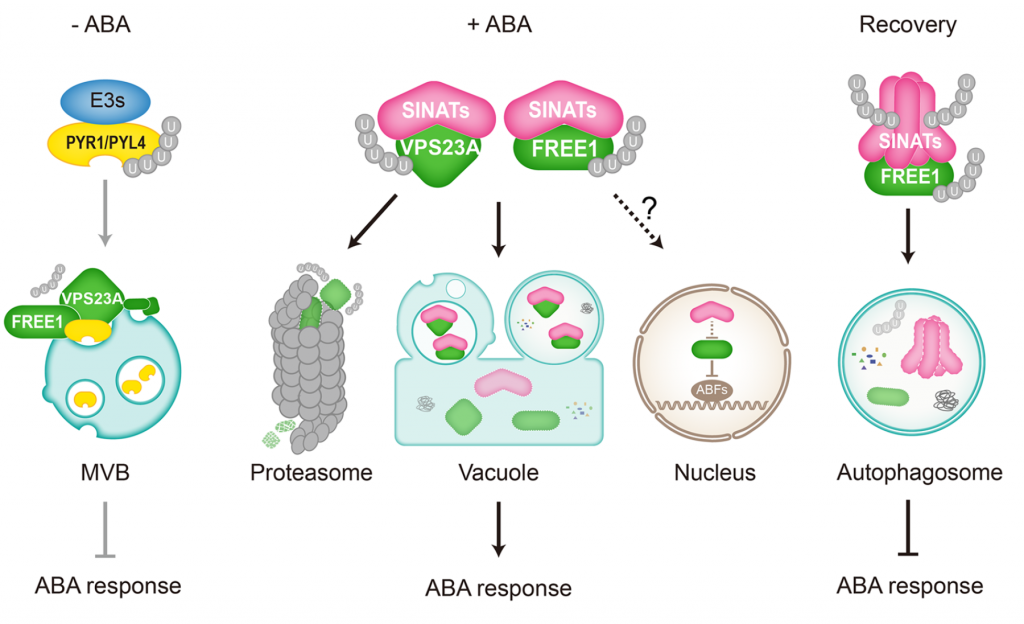 Protein degradation is mediated by several systems: the ubiquitin-proteasome system, multi-vesicle body-mediated vacuolar sorting (MVB), and the autophagy-vacuole pathway. However, the communication between these different protein degradation systems are less characterized. Here, Xia et al. report a new node in mediating crosstalk between the proteasomal and autophagic degradation pathways. They show that the SEVEN IN ABSENTIA of ARABIDOPSIS THALIANA (SINATs), which are RING-type E3 ubiquitin ligases, modulate the protein stability of two proteins involved in mediating autophagy, FYVE DOMAIN PROTEIN (FREE1) and VACUOLAR PROTEIN SORTING 23A (VPS23A). SINAT1/2/4 are localized to the endomembrane and autophagosome vesicles and interact with FREE1 and VPS23A. SINATs control the ubiquitination and co-degradation with FREE1 and VPS23A through the MVB and autophagy-vacuole degradation pathway. Mutants of vps23a and freel knockdown are hypersensitive to ABA treatment, while overexpression of SINATs show increased sensitivity to ABA. Interestingly, during post-ABA recovery, oligomers of SINATs are co-degraded with FREE1 through the autophagy pathway. Overall, this study provides new insights into the interplay between different protein degradation pathways and ABA signalling. (Summary by Min May Wong @wongminmay) Plant Cell 10.1105/tpc.20.00267
Protein degradation is mediated by several systems: the ubiquitin-proteasome system, multi-vesicle body-mediated vacuolar sorting (MVB), and the autophagy-vacuole pathway. However, the communication between these different protein degradation systems are less characterized. Here, Xia et al. report a new node in mediating crosstalk between the proteasomal and autophagic degradation pathways. They show that the SEVEN IN ABSENTIA of ARABIDOPSIS THALIANA (SINATs), which are RING-type E3 ubiquitin ligases, modulate the protein stability of two proteins involved in mediating autophagy, FYVE DOMAIN PROTEIN (FREE1) and VACUOLAR PROTEIN SORTING 23A (VPS23A). SINAT1/2/4 are localized to the endomembrane and autophagosome vesicles and interact with FREE1 and VPS23A. SINATs control the ubiquitination and co-degradation with FREE1 and VPS23A through the MVB and autophagy-vacuole degradation pathway. Mutants of vps23a and freel knockdown are hypersensitive to ABA treatment, while overexpression of SINATs show increased sensitivity to ABA. Interestingly, during post-ABA recovery, oligomers of SINATs are co-degraded with FREE1 through the autophagy pathway. Overall, this study provides new insights into the interplay between different protein degradation pathways and ABA signalling. (Summary by Min May Wong @wongminmay) Plant Cell 10.1105/tpc.20.00267
Spatial profiling of immune competence in plant roots
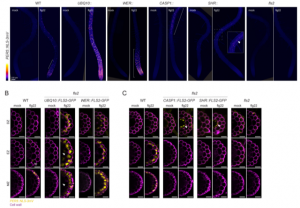 Plant roots should prevent immune activation by innocuous soil microbiota, as constitutive immune activation is harmful to plant growth. Previous studies have indicated variable immune competence of different root cell types and developmental zones, but this is currently poorly understood with the fine spatial resolution. Emonet et al. combined cell-type specific expression of the immune receptor FLS2 (FLAGELLIN SENSING 2) and two fluorescent defense markers, PER5 (PEROXIDASE 5) and MYB51 (MYB DOMAIN PROTEIN 51), to spatially and quantitatively map the immune competence of root cells. Ectopic expression of FLS2 altered spatial expression patterns of PER5 and MYB51 induced by flg22, an FLS2 ligand. Interestingly, PER5 expression was limited to FLS2 expressing cells, while MYB51 expression was not, demonstrating that this analysis can distinguish cell-autonomous and non-cell-autonomous responses. By using a Ca2+ reporter, the authors found non-cell-autonomous induction of a Ca2+ wave upon flg22 treatment. They also found that lignin deposition occurs in various tissues in a cell-autonomous manner, whereas suberin lamellae deposition is endodermis-specific. Strikingly, ectopic expression of FLS2 in epidermal meristematic cells made plants hypersensitive to flagellin peptides derived from commensal bacteria, leading to root growth inhibition by a commensal strain that is harmless to wild type plants. This study reveals varying cell-autonomy and tissue specificity in plant immune responses and the potential importance of these for plant health. (Summary by Tatsuya Nobori @nobolly) bioRxiv 10.1101/2020.08.03.233817
Plant roots should prevent immune activation by innocuous soil microbiota, as constitutive immune activation is harmful to plant growth. Previous studies have indicated variable immune competence of different root cell types and developmental zones, but this is currently poorly understood with the fine spatial resolution. Emonet et al. combined cell-type specific expression of the immune receptor FLS2 (FLAGELLIN SENSING 2) and two fluorescent defense markers, PER5 (PEROXIDASE 5) and MYB51 (MYB DOMAIN PROTEIN 51), to spatially and quantitatively map the immune competence of root cells. Ectopic expression of FLS2 altered spatial expression patterns of PER5 and MYB51 induced by flg22, an FLS2 ligand. Interestingly, PER5 expression was limited to FLS2 expressing cells, while MYB51 expression was not, demonstrating that this analysis can distinguish cell-autonomous and non-cell-autonomous responses. By using a Ca2+ reporter, the authors found non-cell-autonomous induction of a Ca2+ wave upon flg22 treatment. They also found that lignin deposition occurs in various tissues in a cell-autonomous manner, whereas suberin lamellae deposition is endodermis-specific. Strikingly, ectopic expression of FLS2 in epidermal meristematic cells made plants hypersensitive to flagellin peptides derived from commensal bacteria, leading to root growth inhibition by a commensal strain that is harmless to wild type plants. This study reveals varying cell-autonomy and tissue specificity in plant immune responses and the potential importance of these for plant health. (Summary by Tatsuya Nobori @nobolly) bioRxiv 10.1101/2020.08.03.233817
Local auxin biosynthesis is required for root regeneration after wounding
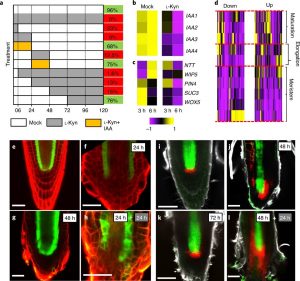 During root development, auxin accumulates at the stem cell niche (SCN) located at the root meristem. Both polar auxin transport and local auxin biosynthesis contribute to the auxin accumulation. During root regeneration after wounding, the source of auxin accumulation is still a question. To address that, Matosevich et al. used an inhibitor of local auxin biosynthesis, L-Kynurenine (L-Kyn), and showed that addition of L-Kyn causes dose-dependent complete loss of regeneration on root cuts. Further analysis of transcriptome time series data on root cuts treated with L-Kyn showed downregulation of auxin-response and regeneration-induced genes, which indicates the role of local auxin biosynthesis in initial wound response and early cell division. The authors also showed the role of local auxin synthesis for tissue pattern identity at later stages of regeneration by using the reporter constructs driven by quiescent-center specific promoter, WOX5, and endodermis specific promoter, SCN. Finally, the authors showed the involvement of ERF115, a regeneration competence factor, in activating the local auxin biosynthetic genes. Overall, the authors in this paper showed that long term stable accumulation of auxin through local auxin biosynthesis is required for root regeneration after wounding. (Summary by Sunita Pathak @psunita980) Nature Plants 10.1038/s41477-020-0737-9
During root development, auxin accumulates at the stem cell niche (SCN) located at the root meristem. Both polar auxin transport and local auxin biosynthesis contribute to the auxin accumulation. During root regeneration after wounding, the source of auxin accumulation is still a question. To address that, Matosevich et al. used an inhibitor of local auxin biosynthesis, L-Kynurenine (L-Kyn), and showed that addition of L-Kyn causes dose-dependent complete loss of regeneration on root cuts. Further analysis of transcriptome time series data on root cuts treated with L-Kyn showed downregulation of auxin-response and regeneration-induced genes, which indicates the role of local auxin biosynthesis in initial wound response and early cell division. The authors also showed the role of local auxin synthesis for tissue pattern identity at later stages of regeneration by using the reporter constructs driven by quiescent-center specific promoter, WOX5, and endodermis specific promoter, SCN. Finally, the authors showed the involvement of ERF115, a regeneration competence factor, in activating the local auxin biosynthetic genes. Overall, the authors in this paper showed that long term stable accumulation of auxin through local auxin biosynthesis is required for root regeneration after wounding. (Summary by Sunita Pathak @psunita980) Nature Plants 10.1038/s41477-020-0737-9
Lipid distribution in cuticles affects flower architecture in Medicago
 Floral architecture influences pollination and reproduction: open flowers facilitate cross-pollination, while closed flowers limit outcross. Some plants of the Leguminosae family (i.e., members of the Papilionoideae subfamily that includes soybean, pea, medicago, lotus) possess a complex architecture, with fused reproductive organs that make controlled pollination and breeding very difficult. In a recent study, Zhu, Li, Xia, and colleagues characterized the stigma exsertion 1 (sge1) mutant in Medicago truncatula in which the flower forms abnormally, allowing the stigma to protrude from it. These changes result from an abnormal curvature of petals and the staminal tube, caused by contact between other organs of the flower. The authors found that the SGE1 gene encodes a G-class ATP-Binding Cassette (ABCG) involved in the transport of cuticle lipids, and cuticle permeability analysis revealed cuticle defects as the cause of the abnormal flower morphology. Functional analysis of other members of the ABCG family in Medicago allowed the identification of MtABCG13; mutations in this gene caused similar alterations in the flower. Since dimerization is an essential feature of these transporters, the authors conducted protein-protein interaction analysis; they found that SGE1 and MtABCG13 can interact physically, suggesting they work together to control cuticle secretions in the flowers. (Summary by Humberto Herrera-Ubaldo @herrera_h) Plant Physiol. 10.1104/pp.20.00014
Floral architecture influences pollination and reproduction: open flowers facilitate cross-pollination, while closed flowers limit outcross. Some plants of the Leguminosae family (i.e., members of the Papilionoideae subfamily that includes soybean, pea, medicago, lotus) possess a complex architecture, with fused reproductive organs that make controlled pollination and breeding very difficult. In a recent study, Zhu, Li, Xia, and colleagues characterized the stigma exsertion 1 (sge1) mutant in Medicago truncatula in which the flower forms abnormally, allowing the stigma to protrude from it. These changes result from an abnormal curvature of petals and the staminal tube, caused by contact between other organs of the flower. The authors found that the SGE1 gene encodes a G-class ATP-Binding Cassette (ABCG) involved in the transport of cuticle lipids, and cuticle permeability analysis revealed cuticle defects as the cause of the abnormal flower morphology. Functional analysis of other members of the ABCG family in Medicago allowed the identification of MtABCG13; mutations in this gene caused similar alterations in the flower. Since dimerization is an essential feature of these transporters, the authors conducted protein-protein interaction analysis; they found that SGE1 and MtABCG13 can interact physically, suggesting they work together to control cuticle secretions in the flowers. (Summary by Humberto Herrera-Ubaldo @herrera_h) Plant Physiol. 10.1104/pp.20.00014
Limited evidence for a consistent seed mass-dispersal trade-off in wind dispersed pines ($)
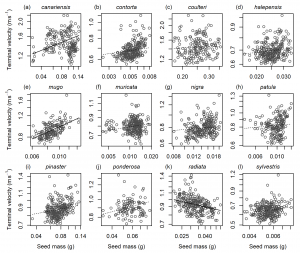 The dispersal capacity of wind-dispersed seeds is expected to be shaped by seed mass, with lighter seeds dispersed further due to low terminal velocity (i.e., maximum velocity while falling). However, this relationship has been mostly tested comparing species from different taxonomic groups, rather than within particular taxa or species. In this paper, Wyse and Hulme assessed the relationship between seed mass and terminal velocity across and within 12 wind-dispersed Pinus species and how they were related to other seed and cone traits. As expected, a significant and positive relationship between seed mass and terminal velocity was found across pine species. However, when analyzed within each species, this relationship was not significant in most cases. Instead, the authors show that seed and cone traits –such as seed shape and cone length– are better predictors of terminal velocity. As a result, the authors highlight that the relationship between seed mass and terminal velocity is highly context-dependent, and that arises from the optimization of multiple reproductive traits. As a result, this research provides interesting insights for future studies about how different functional traits constrain the dispersal capacity of wind-dispersed species. (Summary by Carlos A. Ordóñez-Parra @caordonezparra) J. Ecol. 10.1111/1365-2745.13477
The dispersal capacity of wind-dispersed seeds is expected to be shaped by seed mass, with lighter seeds dispersed further due to low terminal velocity (i.e., maximum velocity while falling). However, this relationship has been mostly tested comparing species from different taxonomic groups, rather than within particular taxa or species. In this paper, Wyse and Hulme assessed the relationship between seed mass and terminal velocity across and within 12 wind-dispersed Pinus species and how they were related to other seed and cone traits. As expected, a significant and positive relationship between seed mass and terminal velocity was found across pine species. However, when analyzed within each species, this relationship was not significant in most cases. Instead, the authors show that seed and cone traits –such as seed shape and cone length– are better predictors of terminal velocity. As a result, the authors highlight that the relationship between seed mass and terminal velocity is highly context-dependent, and that arises from the optimization of multiple reproductive traits. As a result, this research provides interesting insights for future studies about how different functional traits constrain the dispersal capacity of wind-dispersed species. (Summary by Carlos A. Ordóñez-Parra @caordonezparra) J. Ecol. 10.1111/1365-2745.13477
Wheat yield potential in controlled-environment vertical farms
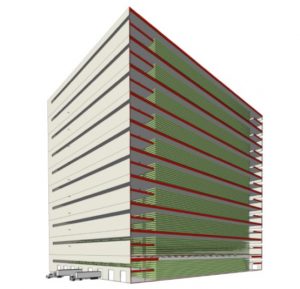 When I think of vertical farms, I imagine baby lettuces and basil: small, leaf crops that benefit from growing close to the consumer. Here, Asseng et al. evaluate the potential to grow wheat, a staple seed crop, in a vertical farm system. Previous studies have demonstrated that wheat can be grown successfully indoors and can reach maturity earlier due to optimal lighting and temperature. Here, the authors model the potential yields if growth were further supported by elevated CO2 and optimal nutrition, as well as the absence of pests and pathogens. They show that the potential yields from an indoor vertical farm could be as much as 600 times that of an average outdoor field and note that water and nutrients can be recycled and so used more effectively. However, the energy costs are prohibitive to make such a system economically viable at this time, although a solar-energy powered “wheat factory” could be a way to supplement variable and low yields in sunny arid regions. (Summary by Mary Williams @PlantTeaching). Proc. Natl. Acad. Sci. USA 10.1073/pnas.2002655117
When I think of vertical farms, I imagine baby lettuces and basil: small, leaf crops that benefit from growing close to the consumer. Here, Asseng et al. evaluate the potential to grow wheat, a staple seed crop, in a vertical farm system. Previous studies have demonstrated that wheat can be grown successfully indoors and can reach maturity earlier due to optimal lighting and temperature. Here, the authors model the potential yields if growth were further supported by elevated CO2 and optimal nutrition, as well as the absence of pests and pathogens. They show that the potential yields from an indoor vertical farm could be as much as 600 times that of an average outdoor field and note that water and nutrients can be recycled and so used more effectively. However, the energy costs are prohibitive to make such a system economically viable at this time, although a solar-energy powered “wheat factory” could be a way to supplement variable and low yields in sunny arid regions. (Summary by Mary Williams @PlantTeaching). Proc. Natl. Acad. Sci. USA 10.1073/pnas.2002655117


